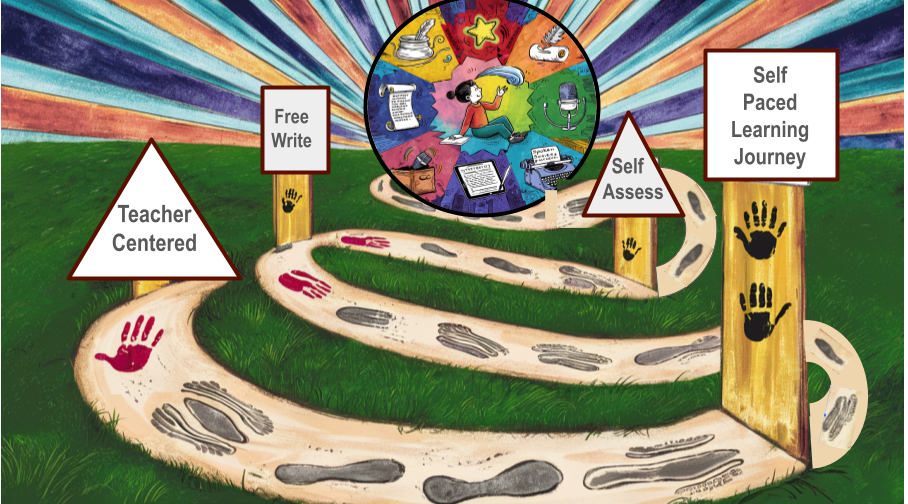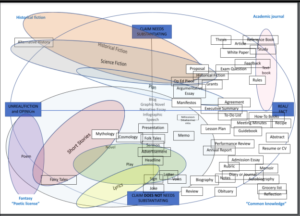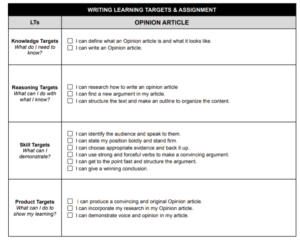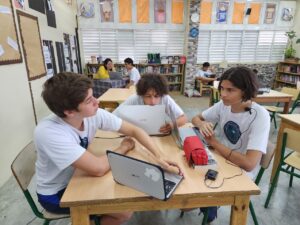Fostering Student Autonomy Through Free Choice Writing

I love the fact that when teachers experiment with new strategies, they’ll naturally want to build on their successes, continually expanding and evolving their practice. When this happens there’s a palpable feeling of excitement and anticipation as they move onto the next steps.
Nicole Jorge, a secondary language arts teacher at TCFL has spent the last few years exploring student autonomy and choice in learning. Observing her as she delves deeper into this concept has been both enlightening and inspiring.
Nicole began using learning journeys (self paced learning with a number of pathways) in her class three years ago. She came up with this idea during our weekly inquiry-based professional learning and she originally planned to use it for six weeks. But the change in her students’ engagement, motivation and love of her class convinced her to keep going. She has consistently used self-paced learning in her classroom ever since.
In her learning journeys students could optionally work on a writing unit, a reading unit or independent reading. Once these were smoothly in place and students were comfortable with learning autonomously, she decided she wanted to take student choice a step further through a free choice writing unit. Although, in all of Nicole’s writing units, students have choice in what they write about, they’d always had to stick to a specific genre. She decided that for this unit she would allow them to choose any type of writing they wanted. Nicole was inspired after hearing Tracey Tokuhama-Espinosa talk about teaching writing and the fact that there are so many different writing products students can work on, yet teachers repeatedly assign the same ones.
To give choice to her students, these are the steps Nicole took:

Understanding: First she introduced the reasoning behind Tokuhama-Espinosas’s thinking, using her genre quadrant.
Brainstorming: Then, she shared this list of possibilities and asked them to reflect: How many of these have you written before? How many are you curious about? Which one would you like to write? Mixed emotions: Students were excited about the possibility of “writing whatever they wanna write” yet they were apprehensive about planning their own units.
Planning: Once they chose what final product they wanted to write, she had them plan out their units:
- To help them write their plan, students referred to the unit plan they were given for their “identity letters”. They were to create learning targets that went from knowledge, reasoning, and skills to product. (Nicole was inspired by Myron Dueck’s unit plans in his book Grading Smarter Not Harder)

Example of student created learning targets.
- Keeping their final product in mind, students would backward design to create their unit.
- One of the knowledge learning targets for all the students referred to the idea of recognizing the traits of a strong (genre of choice) piece.
- They needed to look for one or two mentor texts that they would use as exemplars to guide their writing.
- Nicole says, “Wow! This was hard! I thought that if I went over the structure of the unit plan and used examples from our first units, that it would then be easy for them to emulate the same concept in their own units. But I was mistaken! It wasn’t easy. They struggled especially with reasoning and skill targets.”
- A great deal of conferencing and teacher support was needed to create strong units.
Grouping students: In order to allow students to work more effectively with their peers, Nicole grouped them into sub-genres. For example: Mystery (3 students) Non-fiction (4 students) Screen Plays (3 students), and so on.
Assessment: Nicole wanted to give her students the opportunity to freely choose their own genre, but faced the question: how was she going to ensure that she would assess them all with the same criteria? She decided that they would each create a rubric based on this breakdown of the six traits of writing
- She asked students to apply the six traits of writing to the genre they have chosen to develop single-point rubrics.
- She grouped students into their sub-genres and asked them to work together as they modified each trait to fit their end product. She used their “identity letter” and “social studies reformation paper” rubrics as exemplars to model what they needed to do.
- At first, students seemed confused and were not too sure how to modify the criteria to fit their pieces. Nicole asked them to try with their small groups first, and then she scaffolded their learning by conferencing with them, helping with the first trait (main idea). As soon as she did, most of them understood. They were then able to go through the rest of the traits independently, although they did need additional help with “voice”.
- Students need to create strong rubrics with clear success criteria in order to successfully self-assess at the end of the unit.

Students give each other feedback
Peer and Teacher Conferencing: The class worked independently, but together. They had open conversations about what each of them was writing. On a daily basis, Nicole conferenced with them individually.
Peer feedback: How did this work when everyone was doing something different? “Although they were all working on something different, the rubrics they created came from the same document, so they all shared the same language. Towards the end of the assignment, they did one round of final peer feedback, but throughout the whole process, peer feedback happened organically, mostly because they wanted to share what they were working on.”
The Final Products: “They were beautiful! I had a few students who developed scripts, another wrote an elegy, a speech, a short story in the second person, and even a business proposal for a project. It was a remarkable display of ‘if I had I never been given the choice, I wouldn’t have written (blank)’.”
Nicole’s Final thoughts:
The Pros:
- “All of my students produced a final product, obviously some stronger than others. But, regardless of how strongly written, I got to know my students a lot better by just allowing them to write whatever they wanted to write.”
- “I loved seeing how students were thinking meta-cognitively about how they learn and the steps they take to arrive at a final product.”
- “I was most astounded by the fact that because this was a writing unit, many of them approached writing differently and that would be reflected in their plans.”
- “Students were challenged, not only in writing but also as learners in general, and they rose to the challenge.” Students enjoyed free choice writing, but they certainly didn’t find it easy:
Changes Nicole would make:
- “I recognize that it must have been daunting for the students who don’t do well with only choice and need fewer options than the massive list I shared with them.”
- “Although there are aspects that I would adapt depending on the group, I think the most important change would simply be to assign a self-directed writing piece earlier in the year. I gathered tremendous insight from this assignment that I could have used even more throughout the school year.”
Conclusion:
In order to successfully navigate a free choice writing assignment, these are important steps:
- Give students a list of possible genres to choose from (the length of the list will depend on your group).
- Allow students plenty of time to brainstorm so that they decide on a genre and topic that is meaningful to them.
- Have students create their own learning targets and success criteria with teacher guidance.
- Schedule formal peer conferencing sessions but also allow students to conference with each other organically.
- Consistently meet with students to give support and feedback. Meet with each student at least twice a week.
- Give plenty of time for following the writing process, giving students time and space to create a rough draft, receive feedback and write revisions.
Free writing units are a challenging, engaging way to put students in the driver’s seat of their own learning. If you give it a try please share your findings. And if you want to be in contact with Nicole you can find her on Twitter at @kidswholit and on Instagram at nicolejorge.writes

Leave a comment